Last Updated on January 11, 2023 by TechChecking
Pipe clamps, also known as pipe clips, are relatively simple fittings that are widely used in many DIY projects for installation settings. Although they are not a critical part of internal building construction clamps but play an important role in holding lines in place keeping plumbing secure. If you are a plumber you may know that without clamps, plumbing can break resulting in a catastrophic failure as well as significant damage to the building. So, there is no way we can ignore clamps for building. This is why plumbers use different types of clamps for pipes. In this article, we are going to discuss different types of clamps for pipes for different purposes.
Contents
- What are pipe clamps?
- How do pipe clamps work?
- 12 Different Types of Pipe Clamps
- 1. Adjustable Pipe Clamps
- 2. Cushioned Pipe Clamps
- 3. U-bolts
- 4. Two-Bolt Pipe Clamp
- 5. Three-Bolt Pipe Clamp
- 6. Yoke-Type Pipe Clamp
- 7. Extension Split Pipe Clamp
- 8. Riser Pipe clamp
- 9. Top Beam C-Clamp
- 10. Side Beam Clamp
- 11. Center Beam Clamp
- 12. Pipe Clip
- What To Look At When Choosing A Pipe Clamp?
- Final Words
What are pipe clamps?
Pipe clamps are kinds of fittings that are used in different types of projects and various types of channel support systems such as plumbing, heating, drainage, and electrical work. Pipe clamps are generally circular or semicircular brackets. They can be of different types for different purposes. The pipe clamps fit snugly around the conduit, cables, or tubing you’re installing.
How do pipe clamps work?
Pipe clamps simply work by fixing securely around the pipe. It follows the rail system. Clamps lock around the pipe to keep it in place so that it doesn’t displace or move away. Once the pipe clamp is installed, the pipe becomes secure. There are many types of pipe clamps out in the market and yes, they can work slightly different ways.
12 Different Types of Pipe Clamps
There are different types of clamps found in the market. A pipe clamp is one of them. However, depending on the materials, function, and use, a wide range of piping clamps are used in different applications. Let’s see some pipe clamps below.
1. Adjustable Pipe Clamps
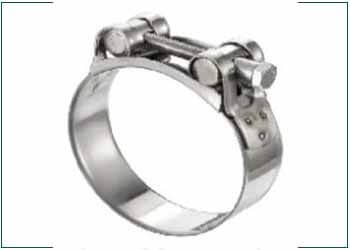
The pipe clamps we are going to explain first are adjustable pipe clamps. They are generally made from steel, plastic, or aluminum. The adjustable pipe clamps have a great feature to adjust themselves as per the required pipe diameter. This is why they are very demandable. These types of pipe clamps can be easily tightened or loosened according to your need. Most importantly, the adjustable pipe clamps are very cost-effective due to their different types of pipe diameters and for universal usage.
2. Cushioned Pipe Clamps
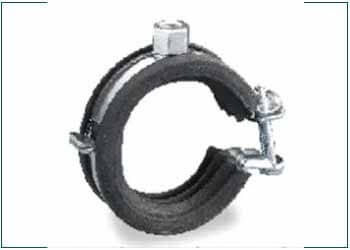
Another type of pipe clamp is cushioned pipe clamp. Cushioned pipe clamps help in avoiding galvanic corrosion by preventing metal-to-metal contact. The cushion doesn’t let that happen. The cushioned pipe clamps are widely used for bare pipes. One thing that is worth testing is how much temperature the cushioned clamps tolerate. Before installing these types of clamps, it is a must to check the temperature.
3. U-bolts
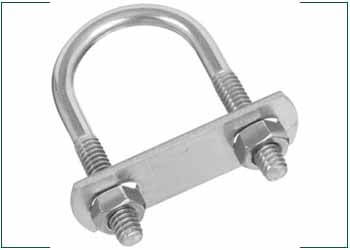
U-bolts are the most widely used pipe clamps. This metal clamp for pipes is extensively used for small bore piping. If the diameter of the pipe is more than 8-inches, the application in terms of using U-bolts reduces to a great extent as the piping loads increase with the increase in pipe sizes.
4. Two-Bolt Pipe Clamp
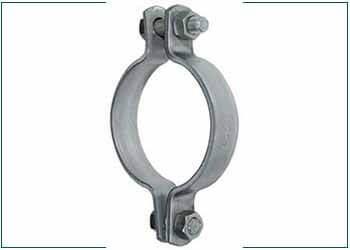
The two-bolt pipe clamp is usually used for the support of horizontal lines. In this case, the pipe requires no insulation. Moreover, the load-carrying capacity is not remarkable. So, you cannot use this two bolt pipe clamp for a heavy-duty job.
The two-bolt pipe clamps are important to work for different purposes.
5. Three-Bolt Pipe Clamp
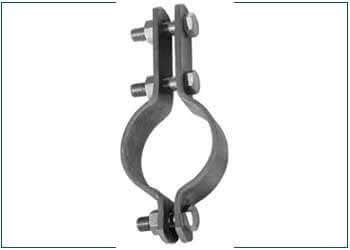
A three-bolt pipe clamp and a two-bolt pipe clamp are almost similar. The only difference in them is the three-bolt pipe clamp has one more additional nut than a two bolt pipe clamp. However, it is true that a three-bolt pipe clamp is more efficient in carrying loads than a two bolt pipe clamp. Besides, a three-bolt pipe cramp is used for suspending insulated lines. The selection of the three-bolt Pipe Clamp depends upon the temperature of the line.
6. Yoke-Type Pipe Clamp
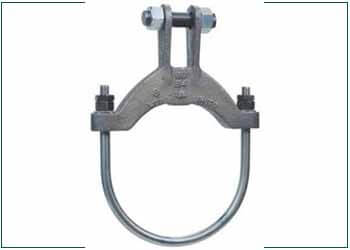
Yoke-type pipe clamps are required for hanging high-temperature horizontal insulated pipes. These types of pipe clamps are 4″ – 6″ insulated lines supported. Yoke-type pipe clamps are capable of taking a heavy load.
Yoke-type pipe clamps are strong and can bear a heady load.
7. Extension Split Pipe Clamp
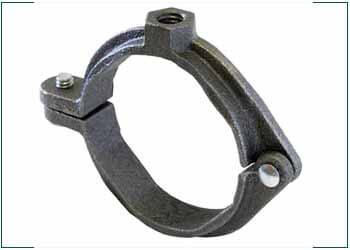
The Extension Split Pipe Clamp is a hinged type clamp. These types of clamps are used for non-insulated horizontal lines with the pipe nipple. You can see an extension split pipe clamp on the refrigeration or compressor piping. If you see this clamp, you can notice, the extension split pipe clamp has been designed in such a way that especially the interior design of the clamp can provide a solid grip on the pipe. In addition, the tapered ring inside is able to prevent successfully the entrapment of condensed moisture.
8. Riser Pipe clamp
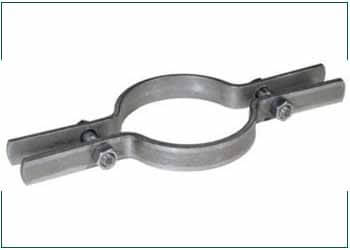
The Extension, also known as riser pipe clamp, is one of the most recommended pipe clamps for the restraint of vertical stationary lines. These types of clamps need not use hanger roads. However, the maximum suggested service temperature for this extension pipe clamp is 343°C.
So, the Riser Pipe Clamp is mostly used clamp all over the world.
9. Top Beam C-Clamp
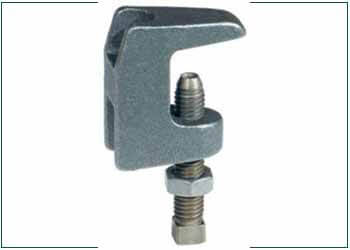
The Top Beam C-Clamp is used for many purposes. We usually see these types of clamps are required under roof installations. It is attached to the top or bottom flange of a structural member. The Top Beam C-Clamp works as a guard by a cup-pointed set screw that is tightened against the flange. In addition, a jam nut is also given to tightening the screw against the body casting.
10. Side Beam Clamp
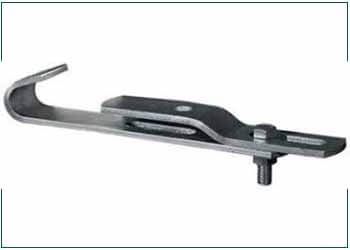
A side beam clamp is important when you are going to attach a hanger rod to run vertically close to the beam’s edge. It is usually used to the bottom flange of the structural member in order to prevent the drilling of holes. So, if you have to work with different widths and thicknesses beam flange, this one will be easily fitted.
11. Center Beam Clamp
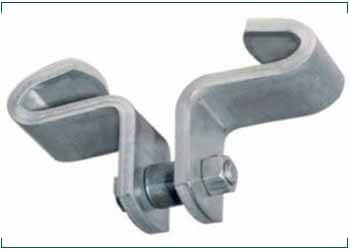
A center beam clamp is used in the suspension of the hanger rod from the center of an I-beam. It can also be attached to the bottom flange of an I-beam. The center beam clamp is good enough to prevent distortion.
The center beam clamp is a heavy-duty clamp to use for any plumbing work.
12. Pipe Clip
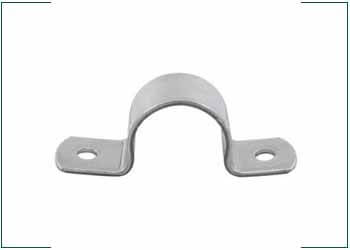
One of the most common and widely used pipe clamps is this pipe clip. This pipe clip is commonly seen in any plumbing work. It is also known as a pipe strap. However, the pipe strap is recommended for the suspension of horizontal stationary lines. You need to make the pipe clip work by using two nuts on the two sides of the pipe strap. They can hold the pipe strongly.
What To Look At When Choosing A Pipe Clamp?
To choose the right pipe clamp, you need to focus on some important factors. Let’s see the factors.
Pipe Materials
You need to make sure the pipe clamp should be compatible with the pipe material. If they are not properly matched, it would be a problem. For example, a SS pipe clamp is required for the SS pipe. It can avoid galvanic corrosion.
Pipe Temperature
Clamps of pipes are usually chosen depending on the temperature variation of the pipe material. Pipes sometimes expand and clamps are selected understanding the withstand power to the fluctuations of the temperature of pipes.
Load Bearing Capability
Besides other features in terms of choosing the right types of clamps for pipes, the load-bearing capability is one of the most considerable factors for a pipe clamp. Generally, all the manufacturers ensure the maximum load-carrying capacity. It happens in both standard and heavy versions of pipe clamps. So, everyone must choose piping clamps after calculating the pipe support loads.
Pipe OD
OD (Outer Diameter) of a pipe affects the pipe clamp selection. Most of the times clamps are manufactured with the feature of minimum to maximum pipe diameters. So, when you are going to buy the piping clamps, you should follow the manufacturer’s catalog for a better idea.
Working Environment
The working environment is another factor that can affect the types of clamps for pipes. Actually, it affects depending on where you are going to install the clamps. This is why you will have to pick the right piping clamps. If the pipe clamps are exposed to the environment, choosing the properly coated piping clamps would be a perfect choice because they can avoid corrosion.
What Materials Are Used to Manufacture Pipe Clamps?
As we already discussed pipe materials are widely used all over the globe. They can be made using different types of materials. It actually depends on quality, budget, nature of use, size, thickness, and so on. However, pipe clamps are manufactured using Carbon Steel, Stainless Steel, Plastic, Copper, Brass, Aluminum, Alloy Steel, Chrome/Chrome-Plated pipe clamps, and so on.
What Are The Mentionable Features of Pipe Clamps?
Every building, house, or construction needs pipe clamps for plumbing works. Without these clamps, pipes are insecure. Most piping clamps have amazing features. The mentionable features of pipe clamps are:
- Simple Operation
- Easy installation
- Adjustable in a small range
- Nice appearance
- Temperature withstand capability
- Impact resistance
- Quick pipe installation and layout
- Shock-absorption capacity
- Vibration dampening property
- Acoustic reduction property
- Suitable for small and large diameter pipes, etc.
What One Is The best type of pipe clamps according to usage
Now if you are thinking about which clamp is the best to choose? Well, the answer is it depends. There are many factors to consider too. We have already covered the main and considerable factors. However, the temperature is one of the most discerning matters to count in. it can create a lot of havoc on a plumbing line in case the wrong clamp is used. Besides, if the clamps are too tight, it may not allow for the line to expand as it heats up. So, it can be a reason for line breaking that results in catastrophic damage to the immediate area.
If we focus on the different materials that clamps are made of, it would be wise too. Size, diameters, and mounting options are important as well.
Stainless steel clamps are very ideal for many exposed areas. They can resist oxidization and corrosion, which is great for both indoor and outdoor use.
Plastic pipe clamps are also suitable in situations where there are cables too much. They are suitable because plastic clamps are also resistant against moisture and discoloration due to UV rays among a few.
Moreover, copper pipe clamps are more commonly used in indoor plumbing. People choose this type of material because it doesn’t cause adverse reactions to water.
On top of that, clamps made of brass look aesthetically appealing. Truth be told, they are also durable and resistant to harsh elements.
So, considering all of them, in my point of view, you should pick the best one according to your need. Read more.
Final Words
In this article, we covered almost every angle about the different types of clamps for pipes. If you need any more information, you can reach out to us. If you are a plumber, you just need to know more about the different types of clamps for pipes in order to do the work professionally and flawlessly.
Articles You May Like –
- How to Cut Wire Rope Cleanly [Step by Step Guide]
- 7 Best Wire Cutters for Electricians
- Different Types of Wire Cutters
- Socket Wrench vs Ratchet – Core Differences
- 9 Best Torque Wrenches Made In USA – Buying Guide 2022

